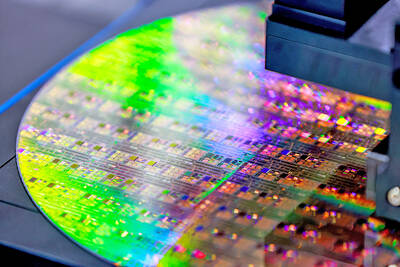OpenAI on Monday released a higher performing and even more human-like version of the artificial intelligence (AI) technology that underpins its popular generative tool ChatGPT, making it free to all users.
The update to OpenAI’s flagship product landed a day before Google is expected to make its own announcements about Gemini, the search engine giant’s own AI tool that competes with ChatGPT head on.
“We’re very, very excited to bring GPT-4o to all of our free users out there,” OpenAI chief technology officer Mira Murati said at the highly anticipated launch event in San Francisco.

Photo: AP
The new model GPT-4o — the “O” stands for omni — will be rolled out in OpenAI’s products over the next few weeks, the company said, with paid customers having unlimited access to the tool.
The company said the model could generate content or understand commands in voice, text or images.
“The new voice (and video) mode is the best computer interface I’ve ever used. It feels like AI from the movies,” OpenAI CEO Sam Altman said in a blog post.
Altman has previously pointed to the Scarlett Johansson character in the movie “Her” as an inspiration for where he would like AI interactions to go.
“Talking to a computer has never felt really natural for me; now it does,” he added.
Murati and engineers from OpenAI demonstrated the new powers of GPT-4o at the virtual event, posing challenges to the beefed-up version of the ChatGPT chatbot.
The demo mainly featured OpenAI staff members asking questions to the voiced ChatGPT, which responded with jokes and human-like banter.
The bot served as an interpreter from English to Italian, interpreted facial expressions and walked one user through a difficult algebra problem.
The company said that GPT-4o had the same powers as the previous version when it came to text, reasoning and coding intelligence, and set new industry standards for multilingual conversations, audio and vision.
OpenAI and its backer Microsoft Corp are in a heated rivalry with Google to be generative AI’s major player, but Facebook-owner Meta Platforms Inc and upstart Anthropic backed by Amazon.com Inc are also making big moves to compete.
All the companies are scrambling to come up with ways to cover generative AI’s exorbitant costs, much of which goes to chip giant Nvidia Corp and its powerful graphics processing units.
Making the new model available to all users may raise questions about OpenAI’s path to monetization amid doubts that everyday users are ready to pay a subscription.
Until now, only lower performing versions of OpenAI or Google’s chatbots were available to customers for free.
“We are a business and will find plenty of things to charge for,” Altman said on his blog.
Separately, Anthropic on Monday announced that its AI assistant “Claude” is available in Europe after launching in the US earlier this year.
Claude can be accessed for free in Europe online at claude.ai or using an app tailored for Apple mobile devices, the San Francisco-based tech start-up said in a blog post.
It is also available to businesses through a paid “Claude Team” subscription plan, the company added.
Anthropic introduced the latest version of Claude in March.
“Claude has strong levels of comprehension and fluency in French, German, Spanish, Italian and other European languages, allowing users to converse with Claude in multiple languages,” the company said.
“Claude’s intuitive, user-friendly interface makes it easy for anyone to seamlessly integrate our advanced AI models into their workflows.”
Founded by former OpenAI employees, Anthropic strives to distinguish itself from its competitors by building stricter safeguards into its technology to prevent it from being misused.
Millions of people are already using Claude for an array of purposes, Anthropic co-founder and chief executive Dario Amodei said.
“I can’t wait to see what European people and companies will be able to create with Claude,” Amodei said.

Taiwan’s rapidly aging population is fueling a sharp increase in homes occupied solely by elderly people, a trend that is reshaping the nation’s housing market and social fabric, real-estate brokers said yesterday. About 850,000 residences were occupied by elderly people in the first quarter, including 655,000 that housed only one resident, the Ministry of the Interior said. The figures have nearly doubled from a decade earlier, Great Home Realty Co (大家房屋) said, as people aged 65 and older now make up 20.8 percent of the population. “The so-called silver tsunami represents more than just a demographic shift — it could fundamentally redefine the

Businesses across the global semiconductor supply chain are bracing themselves for disruptions from an escalating trade war, after China imposed curbs on rare earth mineral exports and the US responded with additional tariffs and restrictions on software sales to the Asian nation. China’s restrictions, the most targeted move yet to limit supplies of rare earth materials, represent the first major attempt by Beijing to exercise long-arm jurisdiction over foreign companies to target the semiconductor industry, threatening to stall the chips powering the artificial intelligence (AI) boom. They prompted US President Donald Trump on Friday to announce that he would impose an additional

China Airlines Ltd (CAL, 中華航空) said it expects peak season effects in the fourth quarter to continue to boost demand for passenger flights and cargo services, after reporting its second-highest-ever September sales on Monday. The carrier said it posted NT$15.88 billion (US$517 million) in consolidated sales last month, trailing only September last year’s NT$16.01 billion. Last month, CAL generated NT$8.77 billion from its passenger flights and NT$5.37 billion from cargo services, it said. In the first nine months of this year, the carrier posted NT$154.93 billion in cumulative sales, up 2.62 percent from a year earlier, marking the second-highest level for the January-September

Asian e-commerce giant Shein’s (希音) decision to set up shop in a historic Parisian department store has ruffled feathers in the fashion capital. Anger has been boiling since Shein announced last week that it would open its first permanent physical store next month at BHV Marais, an iconic building that has stood across from Paris City Hall since 1856. The move prompted some French brands to announce they would leave BHV Marais, but the department store had already been losing tenants over late payments. Aime cosmetics line cofounder Mathilde Lacombe, whose brand was among those that decided to leave following